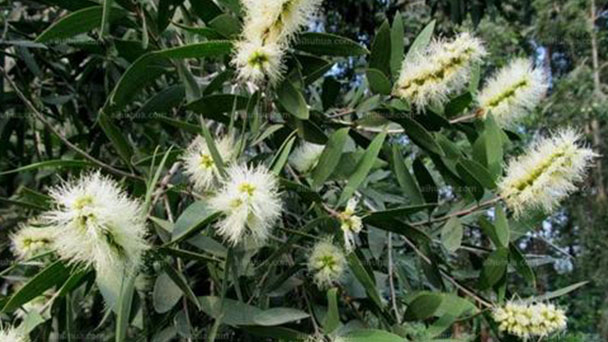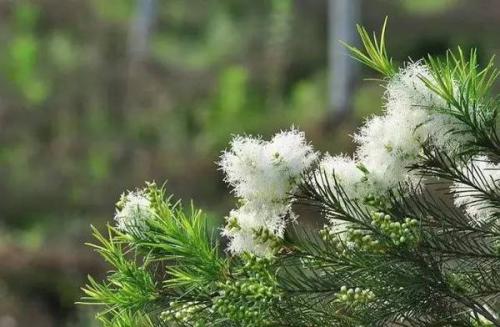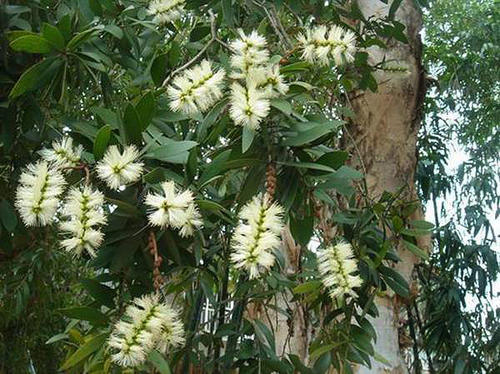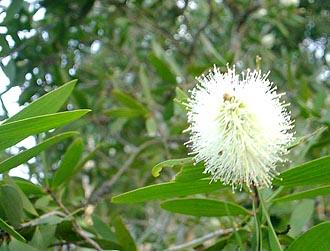Weeping paperbark (Melaleuca leucadendron) profile
Written by Maggie
Mar 11 2021

Weeping Paperbark (Melaleuca leucadendron), also called long-leaved paperbark or white paperbark, belongs to trees, a tropical tree. Weeping Paperbark's bark is pale, thick and loose, flaky flaking. Leaves are alternate, entire. Spicate is terminal, 6-12cm long; Small white flowers with elongated post floral inflorescences becoming leafy new branches, central plant of Australian origin, native to Australia.
The weeping paperbark is elliptic and conical, the tree has graceful and neat posture and thick leaves, which is suitable for viewing and street tree. The medicinal material is the white bark of myrtle plants.
Weeping paperbark picture

The morphological characteristics of the weeping paperbark
Weeping Paperbark is a tree with a height of 18 meters; Bark is grayish white, thick and loose, a thin layer of peeling; The twigs are grayish white.
Weeping Paperbark Leaves alternate, leathery, lanceolate or narrow oblong, 4-10 cm long and 1-2 cm wide, pointed at both ends, 3-5 (-7) basal veins, multiple oil glands, rich aroma; Petiole is very short.
Flowers of Weeping Paperbark are white, densely spicate at branch tips, up to 15 cm long, rachis often short hairs; Calyx tube is ovate, 3 mm long, hairy or glabrous, calyx teeth 5, rounded, ca. 1 mm long; Weeping Paperbark has 5 petals, ovate, 2 -- 3 mm long, 3 mm wide; Stamens ca. are 1 cm long, often 5-8 in bundles; Style is linear, slightly longer than stamens.
Capsule subglobose, 5-7 mm in diameter, flowering multiple times per year.
Weeping paperbark ecological habits
Weeping paperbark likes a warm and humid environment, requires sufficient sunlight, strong adaptability, can withstand drought, high temperature and barren soil, can also withstand light frost and short-term low temperature of about 0℃, and is not strict on the soil.
Weeping paperbark propagation method
Weeping Paperbark is commonly propagated with seeds, and seedlings are transplanted.
From autumn to spring of the next year, when the skins change from reddish brown to dark gray or brown, the fruit branches will be picked and placed in a windless place under the sun for 2-3 days, and the fruits will crack and break out the seeds and unchaff grains. Seeds of Weeping Paperbark can be picked and sown, or dried and stored in a bag.
Sowing and seedling in spring. Because the seeds of Weeping Paperbark are small and the weight of 1,000 seeds is only 0.1g, the soil preparation is required to be careful. The topsoil needs to be sifted, pressed, drench enough water, and the seeds are planted and covered with film. The average daily temperature is above 10℃, and the seeds can germinate 5-6d after sowing. When the seedlings are 6-8cm high and the leaves are close to hard leather, the seedlings can be raised in a different bed.
Change the bed when seedling should apply sufficient base fertilizer, after every month topdressing 1-3 times. Weeping Paperbark can be planted when the seedling height is 1.2m. The size of the planting hole is 40cm in length, width and depth.
Classification of the weeping paperbark varieties
Weeping Paperbark on Mutual Leafs
It belongs to the Weeping Paperbark genus of the Myrtle family and is native to the coastal area at 23.5° south latitude of Australia and the northern part of the Northern Territory. Its tree height up to 6m, trunk tuberous bending, bark layers, soft, elastic, like a sponge; Leaves are alternate, lanceolate, like acacia leaves; Summer to fall flowering, cylindrical spikes at the top of branches, small bottle brush, milky yellow, is a beautiful garden, street and windbreak trees. Each leaf Weeping paperbark or very high economic value of economic crops, the fresh branches and leaves can be extracted essential oil, tea tree oil, it can be highly effective, non-toxic, no stimulation to kill fungi and bacteria on the surface of the human body skin, and also have inhibition to some virus, its sterilization effect is 11-13 times that of phenol, in medicine, food antiseptic, cosmetic skin care and health care products are widely used.
Weeping paperbark (Melaleuca tree)
Demonstrates the principles of ecosystem based management. In Florida alone, an introduced species is threatening human water supplies, land use, nature preserves and wildlife habitats, especially freshwater marshes. The spread of the plant has devastated the landscape of a major tourist area in the United States, raising a range of social and conservation issues. The Plain of Reed and the Mekong Delta in Vietnam are one of the poorest areas in the world, despite efforts to protect it and the value of the locality's economy, culture, and residents on the Weeping PaperBark ecosystem is widely recognized. However, the strict protectionism that park managers have adopted so far is likely to undermine conservation efforts because it ignores ecosystem values. Ecosystem management takes into account all human factors in the ecosystem, enabling the Weeping paperbark ecosystem to potentially continue to provide livelihoods for people in the Mekong Delta.
Weeping Paperbark on five veins (Melaleuca Quinquenervia)
It is native to Australia, New Guinea and New Corridonia.In agriculture, it can be used as shelter forest and soil conservation, and can also be used as ornamental trees. In 1906, a forester at the University of Miami planted the first seeds brought from Melbourne in two areas on Florida's Atlantic coast. In 1936, individual tree planting contests were held to drain the Everglades in southern Florida. In the contest, seeds of the Weeping Paperbark tree were planted on an airplane in southern Florida.

Disease prevention and control of weeping paperbark
The pests on the Weeping Paperbark include ground tigers, large crickets, green elephant trunks, and the main disease is root rot. White-stem layer is more resistant to disease, mainly termite pests, can be controlled by meiLing trap bag, 300 ~ 450 bags /ha, the time should be two months before planting. The specific method is as follows: shovel 5 ~ 6cm of topsoil and lay a layer of dead weeds that termites like to eat, and put some sugar water or rice soup on the weeds to improve the control effect. Then put on the trap after killing the bag and then cover with weeds.
Cutworms
In cutworms 1-3 instars period, using the maggots spirit was 1500 times liquid, 48% 48% cyhalothrin ec was reported or 2.5% days of chlorpyrifos 2000 times liquid, 48% strength puma was 2000 times liquid, 10% efficient efficiency can ec 1500 times liquid, 21% fenvalerate malathion cream 3000 times liquid, 2.5% deltamethrin ec 1500 times liquid, 20% fenvalerate ec 1500 times liquid, chrysanthemum malathion cream 1500 times liquid, 20% to 10%, bromine malathion cream 2000 times liquid, such as the surface spray.
Large cricket
Both adults and nymphs can attack the stems, leaves, fruits, and seeds of Weeping Paperbark, and sometimes the roots of plants. The whole Weeping Paperbark plant of the affected rubber seedling withered and died; Victim seedlings are bitten off the top bud, can not grow normally, and even die.
[Prevention and control method] Add 0.1% trichlorfon into wheat bran, rice bran or various kinds of green tea to make poison bait, and put it into the windward of the mouth of the cave in the evening to trap and kill. In the area with a convenient water source, water can be poured into the cave.
Root rot
Root rot disease, high temperature and rainy season easy to come on, with 50% of the special 1000 times liquid injection.
The distribution area of the weeping paperbark
Weeping paperbark originally produced in Australia, it has been planted in Guangdong, Taiwan, Fujian, Guangxi and other areas of China, and is commonly planted as street trees beside the road, whose bark is easy to cause fire and is not suitable for afforestation.
Uses of the weeping paperbark
Economic purpose
Tea tree oil is an aroma oil processed and refined from the Weeping Paperbark branches and leaves, which has antibacterial, disinfection, antipruritic and antiseptic functions. It is one of the main raw materials for detergents, beauty and health products and other daily chemicals and medical supplies, and has a wide demand. The weeping paperbark tree was cultivated once, which showed effect in the year, the weeping paperbark is harvested annually and can be picked twice a year, and the weeping paperbark can be picked 2000~3000 kg per acre, and the annual income per acre can be increased to 1800~2700 yuan, and it is an excellent greening tree. Therefore, this project is also one of the agricultural industrialization projects.
The Weeping Paperbark twigs provided tasty food for goats, while Carex Marshland was food for water buffalo.
Weeping paperbark oil
Weeping Paperbark oil is the main ingredient of tea tree oil, also known as "Australian gold", which is a magical skin treatment product in Australian Aboriginal legend.
Weeping paperbark garden use
Weeping paperbark is a shade wood class, weeping paperbark bark color, beautiful bark, and has aroma, and can be used as a barrier tree or street tree.

Latest Updated
- Benefits of Bugleweed - 7 Science-backed Health Benefits
- Bugleweed Dangers & Side Effects - Is It Poisonous?
- How to Plant Evergreen Trees - What You Should Know
- When to Plant Evergreens - Grow Guide for Evergreen Trees
- 12 Wonderful Evergreen Shrubs for Your Garden
- 12 Popular Evergreen Plants with Pictures for Beginners
- When And How To Prune A Lilac Bush Like a Pro
- How to Grow & Care for Lilac Vine (Hardenbergia Violacea)
- Japanese Lilac Tree (Syringa Reticulata) Care & Propagation Guide
- Shumard Oak Pros and Cons - What to Know
Popular Articles
- Winter maintenance of Antirrhinum Majus
- How to Grow Terminalia Mantaly Tree
- How to Grow and Care for Crossostephium Chinense
- How to grow Antirrhinum Majus in spring
- Peristeria Elata (Dove Orchid) Profile: Info & Care Guide
- Underwatered Snake Plant (Sansevieria Trifasciata) - Signs And How To Fix
- How to Care for Brazilian Jasmine Plant (Mandevilla Sanderi)
- How to Grow & Care for Graptopetalum Purple Delight in Summer
- Rosa Chinensis (China Rose): Plant Growing & Care Tips
- How to Care for Baby Sun Rose (Aptenia Cordifolia)